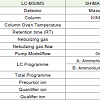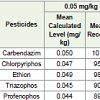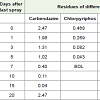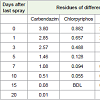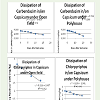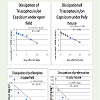Research Article
Dissipation of Certain Pesticides on/in Capsicum in Open Field & Poly House
Kavitha K, Shashi Vemuri*, Aruna M and Swarupa S
Corresponding author: Shashi Vemuri, All India Network Project on Pesticide Residues, Professor JayashankarTelangana State Agricultural University, Rajendranagar, Hyderabad-500030, Telangana, India, E-mail: Sash_3156@yahoo.co.in
Citation: Kavitha K, Shashi V, Aruna M, Swarupa S. Dissipation of Certain Pesticides on/in Capsicum in Open Field & Poly House. J Plant Sci Res.02 2016;3(2): 160.
Copyright © Kavitha K, et al., 2016. This is an open access article distributed under the Creative Commons Attribution License, which permits unrestricted use, distribution, and reproduction in any medium, provided the original work is properly cited.
Journal of Plant Science & Research | ISSN: 2349-2805 | Volume: 3, Issue: 2
Submission: 03/09/2016; Accepted: 04/10/2016; Published: 09/10/2016
Abstract
Studies were undertaken to establish dissipation of commonly used insecticides at recommended dose both in open field and poly house situations to assess the differences in rate of dissipation, and also to recommend Pre-Harvest Intervals based on MRLs established by CAC and FSSAI by utilizing Carbendazim, Chlorpyriphos, Ethion, Triazophos and Profenophos sprays and capsicum samples collected at regular intervals were analyzed for residues. The dissipation pattern of insecticides in open field conditions showed that initial deposit of 2.47 mg kg-1 of carbendazim dissipated to 0.04 mg kg-1 by 15 days whereas Chlorpyriphos 0.468mg kg-1 dissipated to BDL by 7th day. Similarly Ethion (0.746mg kg-1 dissipated to BDL by 10th day, whereas Triazophos (1.947mg kg-1) dissipated to BDL by 15th day (1.947mg kg-1) to BDL by 10th day. As no MRLs are available for, PHI of 10 days can be recommended as residues dissipated to less than 0.05mg kg-1. As per the Insecticide Act, 1968, profenofos is not recommended for use, but when sprayed at farmer's dose on capsicum, 2.24mg kg-1 and 3.71mg kg-1 initial deposits were recorded in open field and poly house, respectively. Codex suggests MRL as 10mg kg-1,hence it can be concluded that profenofos application does not leave residues above MRL. Out of five insecticides tested in poly house. Chlorpyriphos and profenophos residues are found in capsicum up to 10 days, while carbendazim, Ethion and Triazophos are detected up to 15 days.
Keywords: Open field and poly house dissipation; Pre-Harvest intervals
Introduction
Capsicum (Capsicum annum L.), also called "Bell pepper", is animportant commerical crop in India and suffers major quantitativeand qualitative loss in production due to capsicum thrips, Scirtothripsdorsalis Hood and yellow mite, Polyphagotarsonemus latus (Banks) and fruit borers Helicoverpa armigera (Hubner). A number of pesticides are being frequently used, to combat these pests. However, some of these insecticides leave residues on fruits and these residues may persist up to harvest. Presence of pesticide residues in the harvested capsicum is posing problem at the time of export and in recent times importing countries have rejected few consignments. Pesticide use has increased rapidly over the last two decades at the rate of 12% per year [1]. Many farm gate capsicum samples showed presence of insecticide residues [2]. As per insecticides Act of 1968 (www.cibrc.nic.in) [3], 37 insecticide formulations are registered and recommended for use on capsicum targeting various pests. In recent years due to the support of the Government under National Horticulture Mission (NHM), capsicum is widely cultivated under poly house conditions as well as in open field conditions. Sincethe persistence and dissipation of insecticides, the present study isproposed to monitor the pesticide usage on capsicum, dissipation studies of recommended pesticides, so as to recommend the safe waiting periods based on the Maximum Residue Limits (MRLs) calculated, as it helps in recommending risk mitigation protocols for food safety.
Material and Method
Residue analysis method
AOAC Official Method 2007.01 (QuEChERS): 0 day samples were collected for estimation of deposits of pesticide within 2 hours of last spray, and the samples of Capsicum were collected at 1, 3, 5 ,7 ,10, 15, 20 days after last spray or till they reached BDL for residue estimation.
Extraction and clean up procedure.
• 2kg Capsicum Fruits were collected randomly from each plotin polythene bags.
• The samples were homogenized with robot coupe blixer.
• Homogenized 15±0.1 g sample was taken in 50ml centrifuge tube, and 30±0.1 ml acetonitrile was added.
• The sample was homogenized at 14000-15000rpm for 2-3min using heidolph silent crusher.
• The samples were then added with 3±0.1g sodium chloride and mixed by shaking gently followed by centrifugation for 3min at 2500-3000rpm to separate the organic layer.
• The top organic layer of about 16ml was taken into the 50mlcentrifuge tube and added with 9±0.1g anhydrous sodium sulphate to remove the moisture content.
• 8ml of extract was taken in to 15ml tube, containing 0.4±0.01gr PSA sorbent (for dispersive solid phase d-SPE cleanup) and 1.2±0.01 g anhydrous magnesium sulphate.
• The sample tube was vortexed for 30sec then centrifuged for 5min at 2500-3000rpm.
• The extract of 1ml Acetonitrile was transferred into 2ml vialby filtering through 0.2μm filter paper for analysis on LC-MSunder standard operational conditions [Table 1].
Certified Reference Materials (CRMs) of Carbendazim, Chlorpyriphos, Ethion, Triazophosand Profenophos from Dr. Erhenstorfer, Germany were utilized for preparing working standards which were injected into were injected to Liquid Chromatograph with Photo Diode Array (PDA) Detector for estimating the lowest quantity of these pesticides under standard operating parameters Table 1. One micro litre of each working standard was injected for the study. The retention times of Carbendazim, Chlorpyriphos, Ethion,Triazophos and Profenophos were 9.95, 11.87, 6.99 and 5.27min, respectively. Under standard operating parameters Table 1. Working standards of Carbendazim, Chlorpyriphos, Ethion, Triazophos and Profenophos (0.05 ppm, 0.075 ppm, 0.10 ppm, 0.25 ppm and 0.50 ppm) were injected 6 times and the linearity lines were drawn the LOD (limit of detection) for Carbendazim, Chlorpyriphos, Ethion, Triazophos and Profenophos 0.05ng, and the linearity is in the range of 0.05ng to 0.10ng.
Method valilidation and fortification recoveries
Prior to pesticide application and field sample analysis, the residueanalysis method was validated following the SANCO document (12495/2011). The capsicum fruits (5kg) collected from untreated control plots were brought to the laboratory, homogenized using Robot Coupe Blixer (High volume homogenizer) and 15g sample was taken in to 50ml centrifuge tubes. The required quantity of Carbendazim, Chlorpyriphos, Ethion, Triazophos and Profenophos intermediary standard prepared from CRMs were added to each sample to get fortification levels of 0.05ppm, 0.25ppm and 0.5ppm,in three replications each. These foritifcation levels are selected toknow the suitability of the method to detect and quantify pesticidesin capsicum below Maximum Residue Limits (MRLs) of Codex Alimentarius Commission (CAC).
The AOAC official method 2007.01 (Pesticide Residues of Foods by Acetonitrile Extraction and Partitioning with Magnesium Sulfate) was slightly modified to suit to the facilties available at the laboratoryand the same was validated for estimation of LOQ (Limit of Quantification) of above mentioned pesticides in Capsicum matrix. The Quechers method was followed as presented in the flow chart. The final extract of the sample i.e. 2ml equal to 1g of the sample was evaporated using turbovap and made up to 1ml (equal to 1g sample) using suitable solvent for analysis on GC, while for LC analysis, filtered 1ml final extract (equal to 0.5g sample) was directly injected in LC and the residues of pesticides recovered from fortified samples were calculated using the following formula.

Fortification and recovery studies
The untreated/control Capsicum samples were fortified at 0.05, 0.25, and 0.50 mg/kg levels adding required quantity of Carbendazim, cholorpyriphos, ethion, profenophos and triazophos standards. All the fortified levels were replicated thrice. Recoveries of all pesticidesat three fortification levels are presented in Table 2.
The recovery of carbendazim is 101.13 % from the Capsicum kg fortified level while the samples fortified with 0.50mg/kg have shown the recovery of 96.95%. The recovery of Chlorpyriphos is 95.73% from the Capsicum samples fortified at 0.05mg/kg, and 105.83% recovery at 0.25mg/kg fortified level while the samples fortified with 0.50mg/kg have shown the recovery of 103.97%. The recovery of Ethion is 98.74% from the Capsicum samples fortified at 0.05mg/kg, and 104.58% recovery at 0.25mg/kg fortified level while the samples fortified with 0.50mg/kg have shown the recovery of 117.88%. The recovery of Triazophos is 90.39 % from the Capsicum samples fortified at 0.05mg/kg, and 95.96% recovery at 0.25mg/kgfortified level while the samples fortified with 0.50mg/kg have shownthe recovery of 97.04%. The recovery of Profenophos is 89.2% from the capsicum samples fortified at 0.05mg/kg, and 97.8% recovery was seen at 0.25mg/kg fortified level while the samples fortified with 0.50mg/kg have shown the recovery of 93.6%.
Results and Discussion
The dissipation pattern of all the pesticides on capsicum in openfield conditions and playhouse are presented hereunder in Table 3 and Table 4, Figure 1,Figure 2.
Dissipation of carbendazim
The initial deposit and subsequent residues of carbendazim oncapsicum in open field and poly house situation at an interval of 0, 1,3, 5, 7, 10, 15 and 20 days after second spray are presented in Tables3 and 4. In open field situation, the initial deposit of 2.47mg kg-1 gradually dissipated to 1.98, 1.31, 1.02,mg kg-1 at 1, 3 and 5 days, respectively. The per cent dissipation was 19.83, 46.96 and 58.70, respectively. The residues fell Below Determination Level (BDL)of 0.05mg kg-1 by 15th day. There are no maximum residue limits (MRL) for carbendazim on capsicum as per Codex Alimentarius Commission (CAC), while Food Safety and Standards Authorityof India [4] suggests 2mg kg-1 for fruits and vegetables, and hence safe waiting period of 1 day can be suggested, as the initial deposits are less than the MRL. In poly house, initial deposits of 3.80mg kg-1 were detected, which dissipated to 0.08mg kg-1 by 15th day after the second spray. The residues of 2.85, 2.57, 1.46, 1.08 and 0.51mg kg-1 were recorded at 1, 3, 5 and 7 and 10 days, respectively and dissipatedto 25, 32.36, 61.57, 71.57 and 86.57 per cent on 1, 3, 5 and 7 and 10th day, respectively. The results showed that the residues of carbendazim
reached Below Determination Level (BDL) of 0.05mg kg-1 in 20 days. There are no maximum residue limit for carbendazim in capsicum as per Codex Alimentarius Commission (CAC) while Food Safetyand Standards Authority of India (FSSAI) suggests 2mg kg-1 forvegetables, and hence based on the present study, PHI of 15 days can be recommended as the residues degraded to BDL by 15th day.It is evident that there is clear difference in dissipation pattern ofcarbendazim in poly house and open fields. Initial deposit of 2.47mgkg-1 was recorded in open fields, where as it was 3.80mg kg-1 in poly house.
Dissipation of Chlorpyriphos
The dissipation pattern of Chlorpyriphos on capsicum in openfield and poly house situation at an interval of 0, 1, 3, 5, 7, 10, 15and 20 days after second spray are presented in Table 3 and Table 4. The initial deposit of 0.468mg kg-1 on capsicum in open field situations dissipated to 0.269, 0.082 and 0.043mg kg-1 at 1, 3 and 5 days with percent dissipation of 42.52, 82.48 and 90.81, respectively. The residues of Chlorpyriphos dissipated to below determination limit of 0.05mg kg-1 by 7th day. There are no MRLs suggested for Chlorpyriphos in capsicum by either Codex Alimentarius Commission (CAC) or by Food Safety and Standards Authority of India (FSSAI), since no MRLs are available, PHI of 5 days can be recommend as the residues dissipated to 0.043mg kg-1. In poly house, initial deposits of 0.882mg kg-1 Chlorpyriphos detected at 2 hours after last spray, dissipated toBelow Determination Level (BDL) of 0.05mg kg-1 by 10th day after last spraying on capsicum and the initial deposits dissipated to 0.657, 0.488, 0.128, 0.094 and 0.055mg kg-1 by 1, 3, 5 7 and 10 days after last spray, respectively. The dissipation pattern showed decrease of residues from first day to 7th day and residues dissipated by 67.56, 70.27, 81.08 and 86.48% at 1, 3, 5 and 7 days, respectively. The regression equation was Y = 0.256 + (-0.035) X with R2 of 0.607.
Dissipation of Ethion
The Capsicum samples collected at regular intervals were analyzedfor Ethion residues and the residue data is presented in Table 3 and Table 4. The initial deposits of 0.746mg/kg of Ethion were detected in Capsicum samples in open fields dissipated to below detectable level by 7th day. In the poly house the initial deposits of 2.813 dissipated to 2.186 by 1st day and 0.013 by 15th day.
Dissipation of Triazophos
The Capsicum samples collected at regular intervals were analyzed for Triazophos residues and the residue data is presented in Table 3 and Table 4. The initial deposits of 1.947mg/kg of Triazophos detected in Capsicum samples in open field conditions dissipated to below detectable level by 10th day whereas in poly house situation the initial deposit of 2.911 dissipated to BDL by 20 days.
Dissipation of Profenophos
The residue data of profenophos from the studies conducted in open field and poly house situation is presented in Table 3 and Table 4. Profenophos is not registered for use on capsicum as per Insecticide Act, 1968, but based on the survey reports, it is very much evident that profenophos is most popular and commonly used pesticide and hence, field trial was conducted based on the farmer’s practice dose @ 500 g a.i ha-1 to study the dissipation pattern. The study revealed that the initial deposits of 2.24mg kg-1 (at 2 hours after last spray) dissipated to Below Determination Level (BDL) of 0.05mg kg-1 by 10th day after last spraying on capsicum. The initial deposits dissipatedto 1.26, 0.76, 0.47 and 0.18mg kg-1 by 1, 3, 5 and 7days after last spray, respectively. The residues dissipated by 43.75, 66.07, 79.01 and 91.96% at 1, 3, 5 and 7 days, respectively. The regression equation was Y = 1.821 + (-0.262) X with R2 of 0.858. As the Indian Government does not recommend profenophos on capsicum, MRLs are also notset. However, maximum residue limit for profenophos in capsicumare set by Codex Alimentarius Commission (CAC) and European Union (EU) as 10mg kg-1. Based on the present investigations, it can be concluded and recommended that a PHI of 1 day is good for food safety when profenophos is applied. In poly house experiment, initial deposits of 3.71mg kg-1 of profenophos were detected at 2 hours afterlast spray, which dissipated to Below Determination Level (BDL) of0.05mg kg-1 by 15th day after last spraying on capsicum, indicating that profenophos dissipation is slow in poly house compared to open fields. The initial deposits dissipated to 2.24, 1.27, 0.66, 0.33 and 0.17mg kg-1 by 1, 3, 5, 7 and 10 days after last spray, respectively. The residues dissipated by 39.62, 65.76, 82.21, 91.10 and 95.41% at 1, 3, 5, 7 and 10th days, respectively. The regression equation was Y = 2.788+ (-0.321) X with R2 of 0.797. As the Indian Government does not recommend profenophos on capsicum, MRLs are also not set. However, maximum residue limit for profenophos in capsicum are set by Codex Alimentarius Commission (CAC) and European Union (EU) as 10mg kg-1. Based on the present investigation, it can be concluded and recommended that a PHI of 1 day is good for food safety when profenophos applied on capsicum in poly house. From Table 3 and Table 4, it is evident that there is a clear difference in dissipation pattern of profenophos in poly house and open fields. Initial deposit of 3.71mg kg-1 was recorded in poly house, where as in open fields it was2.24mg kg-1. Profenophos reached Below Determination Level (BDL) of 0.05mg kg-1 by 15th day in poly house whereas, in open field trial by 10th day. The results are in full agreement with the findings of Ahmad et al. [5] who reported that profenophos spray on tomato @ 500 g a.i. ha-1, resulted in initial deposit of 2.58 mg kg-1 dissipating to BDL in 15 days and similar results were also reported by Sahoo et al. [6] on tomato. Various workers suggested safe waiting periods varying from 1 to 14 days, but as per CCPR guidelines based on CAC MRLs (10mg kg-1) it is not necessary to recommend waiting periods till the residues reach BDL, and taking into consideration of MRLs set by CAC and results on dissipation dynamics on capsicum in present study, it can be scientifically concluded and recommended that PHI of 1 day isexceedingly good as the initial deposits are well below 10mg kg-1. Experimental results of Radwan et al. [7] show that at application of very high dose @ 1280 g a.i. ha-1 on three crops viz., green pepper, hot pepper and brinjal resulted in very high initial deposit of 10-11mg kg-1 on pepper and 4.50mg kg-1 on brinjal, which dissipated to BDL in 2 weeks. However, the studies conducted by various workers [8-10] on dissipation on profenophos on different crops clearly indicates that when applied at recommended dose, the initial deposits are less than 3mg kg-1 and dissipate to BDL in 7-10 days depending on the crop, except on cardamom.
References
- Thacker NP, Bassin JK, Nitnaware V, Vaidya P, Das SK, et al. (2005) Proceeding of the national seminar on pesticide residues and their risk assessment.
- Singh B, Gupta A, Bhatnagar A, Parihar NS (1999) Monitoring of pesticide residues in farmgate samples of capsicum. Pesticide Research Journal 11: 207-209.
- Central Insecticide Board and Registration Committee (2014) Major uses of pesticides.
- Food Safety and Standards Authority of India (2014) Maximum Residue Limits for pesticides on tomato.
- Ahmed AR, Tarek MM, Rady AR, Mohamed YH (2009) Dissipation of Profenofos, Imidacloprid and Penconazole in Tomato Fruits and Products. Bull Environ Contam Toxicol 83: 812-817.
- Sahoo SK, Sharma RK, Battu RS, Singh B (2009) Dissipation kinetics of flubendiamide on chili and soil. Bull Environ ContamToxicol 83: 384-387.
- Radwan MA, Shiboob MM, Elamayem A, Aal AA (2004) Pirimiphos-methyl residues in some field grown vegetables and removal using various washing solutions and kitchen processing. Int J Agric biol 6: 1026-1029.
- Gupta S, Gajbhiye VT, Sharma RK, Gupta RK (2011) Dissipation of cypermethrin, chlorpyriphos, and profenofos in tomato fruits and soil following application of pre-mix formulations. Environmental Monitoring and Assessment 174: 337-345.
- Renuka S, Rajabaskar D, Regupathy A (2006) Persistence and dissipation of profenofos 50 EC in cardamom. Indian J. Plant Prot 34: 165-167.
- Katroju R, Cherukuri SR, Cherukuri SB, Reddy NK (2014) Dissipation pattern of profenophos in tomato. International Journal of Applied Biology and Pharmaceutical Technology 5: 252-256.

